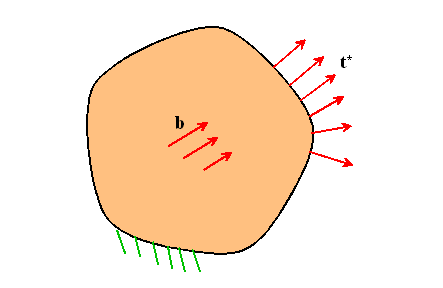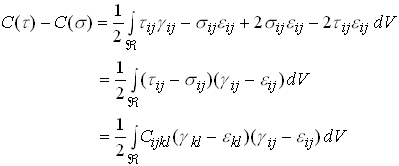 EN224: Linear Elasticity
EN224: Linear Elasticity 
Division of Engineering
8.5 The Principle of Stationary and Minimum Complementary Energy
In our potential energy formulation, we considered a family of kinematically admissible displacement fields, and defined V(v) so that the elastostatic state minimized V.
We can devise an alternative variational method in which we consider
a family of statically admissible stress fields, and define complementary
energy![]() so that the elastostatic stress field minimizes C.
so that the elastostatic stress field minimizes C.

Let us make this precise.
Let ![]() with
with

In addition, define the components of the compliance tensor such that
Now, define a statically admissible stress field ![]() which satisfies
which satisfies

Define the strain energy density associated with ![]() as
as
Define the complementary energy C as
We will proceed to show several important properties of C.
(1) C is stationary for ![]()
(2) If C is stationary for some ![]() , then
, then ![]()
(3) ![]()
The Principle Of Stationary Complementary Energy
C is stationary if and only if ![]() with
with ![]() on
on ![]() .
.
Proof. We will show first that if![]() with
with ![]() on
on ![]() then
C is stationary.
then
C is stationary.
Begin by computing the first variation of C. We could use the same procedure we followed in discussing the principle of stationary potential energy, but just for variety, we will this time use the formal machinery of the calculus of variations.
First, let us define a statically admissible variation in stress Let
where

Then, the first variation of C is defined as

Hence
Note that we may write
where we have used the symmetry of ![]() .
.
Now, substitute into the expression for ![]() and integrate by parts
and integrate by parts

where we have noted that ![]() on
on ![]() , while
, while ![]() on
on ![]() .
.
This completes the first part of the proof.
Next, consider the converse. We wish to show that if C is stationary,
then ![]() , with
, with ![]() on
on ![]() .
.
If C is stationary, then
In particular, choose
where ![]() is a tensor function of position and
is a tensor function of position and ![]() is the permutation
symbol. One may readily verify that
is the permutation
symbol. One may readily verify that
as required for a statically admissible variation. Hence
Now, recall that ![]() , so we may choose
, so we may choose ![]() and
and ![]() on
on ![]() .
Then, integrate by parts twice to see that
.
Then, integrate by parts twice to see that
Since this holds for all ![]() , it follows that
, it follows that
This is the strain equation of compatibility (See
Section 1.5) and implies (at least for a simply connected region) that
there exists a single valued displacement ![]() with
with
Finally, we need to show that ![]() . Follow the procedure in
the first part of the proof to see that
. Follow the procedure in
the first part of the proof to see that
Then, choose
to obtain the required result.
The Principle of Minimum Complementary Energy
We will now go a step further, and show that C is a global minimum only for the compatible stress field. We could show this using the procedure we used to prove minimum potential energy, but just for variety we will do things slightly differently.
As before, let ![]() with
with

In addition, define the components of the compliance tensor such that
Define a statically admissible stress field ![]() which satisfies
which satisfies

Denote the strain energy density associated with ![]() as
as
and define
Now, consider
Noting that both ![]() and
and ![]() are equilibrium fields, we may write
are equilibrium fields, we may write

Integrate by parts

The last two integrals evidently sum to zero if ![]() and
and ![]() .
Expand the remaining terms in terms of strains
.
Expand the remaining terms in terms of strains

Finally, using the properties of the stiffness tensor, we see that
with equality if and only if ![]() .
.